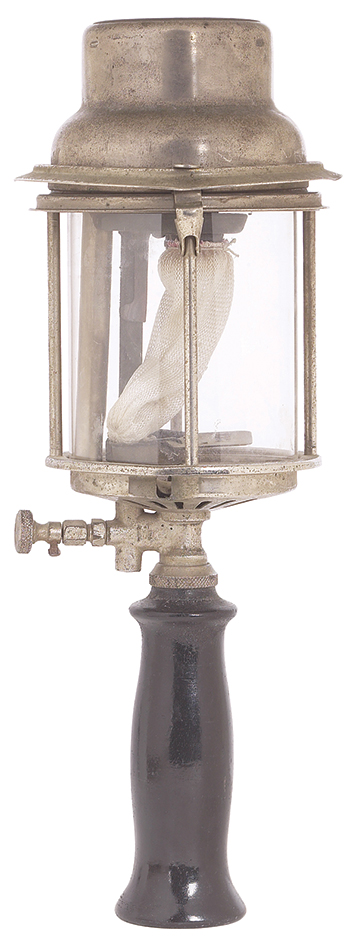Lamp is any device made to produce light. It ranks as one of the most important inventions. Since the invention of the lamp thousands of years ago, people have not had to depend entirely on the sun for light. Lamps enable people to work and to take part in countless other activities by artificial light.

Through the centuries, people have made many kinds of lamps. But all of them have been one of three basic types: (1) fat or oil, (2) gas, or (3) electric. Today, people use electric lamps almost entirely. Some people keep other kinds in case electricity is not available.
Fat or oil lamps
produce light by burning fat, grease, oil, or wax as fuel. These lamps have a wick that performs two functions. The wick serves as a place for the flame to form, and it draws the fuel up to the flame by capillary action(see Capillary action ).
The first lamps were fat lamps, which prehistoric people made from sea shells or hollowed-out stones. They used pieces of grasslike plants called rushes as wicks and burned animal fat as fuel in these lamps.
The ancient Egyptians also made stone lamps. But the Egyptian lamps burned oil and had cotton wicks. The ancient Greeks and Romans made lamps from bronze or pottery. Early Greek lamps looked like saucers and burned olive oil or the oil of other plants. The wick simply floated on the oil. Later Greek lamps had a groove at the edge of the saucer to hold the wick. Some Roman lamps resembled a teakettle. The body of the “kettle” held the oil, and the “spout” held the wick.
Candles are a type of fat lamp. The earliest candles were made by coating a wick with wax and pitch. Later, candlemakers used tallow, a waxy substance obtained from animal fat. The best candles consisted of beeswax or paraffin, a wax obtained from petroleum. Most candles cost more than other types of lamps. Inexpensive lamps called rushlights burned like candles. They were made by dipping dried rushes into animal fat. See Candle .
A type of oil lamp called a cruise appeared in Scotland during the Middle Ages. This lamp consisted of an iron pan that had a trough sticking out from it. The trough held the wick. Many cruises had a second trough beneath the first to catch any dripping oil. The American colonists made cruises called Betty lamps. The colonists usually burned fish oil or whale oil in these lamps.
Through the years, people added reflectors to lamps to diffuse (spread out) or concentrate the light. Otherwise, few improvements occurred in lamps until the late 1700’s. In the 1780’s, a Swiss chemist named Aime Argand invented a lamp with the wick bent into the shape of a hollow cylinder. Such a wick allowed air to reach the center of the flame. As a result, the Argand lamp produced a brighter light than other lamps did. Later, one of Argand’s assistants made another improvement after discovering that a flame burns better inside a glass tube. His discovery led to the invention of the lamp chimney, a clear glass tube that surrounds the flame. During this period, whale oil and colza oil, an oil from the rape plant, became important fuels for lamps. The birth of the oil industry in the mid-1800’s led to the widespread use of kerosene, a petroleum product, as lamp fuel.
Gas lamps
produce light by means of one or more small gas flames. These lamps need no wick. The gas flows from the lamp through a small opening and then burns after mixing with air. Gas lamps burn many kinds of gas, including acetylene, butane, coal gas, natural gas, producer gas, and water gas.
William Murdock, a Scottish engineer, developed the first commercially important gas lamps. In 1792, Murdock lit his home with gas lamps that burned coal gas. By the early 1800’s, gas lamps had come into use as street lamps in London and other cities. Gas lamps served as important sources of light until the late 1800’s, when electric lamps began to replace them.
The gas lamp had one chief problem, the open gas flame. The flame often flickered and produced uneven light. Some gas lamps had a glass chimney, like that of an Argand lamp, to help control the flickering. In the late 1800’s, a device called a mantle solved the problem. A mantle is a loosely woven cloth bag that is soaked with a chemical substance. The mantle glows steadily as the gas burns around it. Most modern gas lamps, including the portable gas and liquid fuel lamps used by campers, have mantles.

Electric lamps
produce light by means of electric energy. The American inventor Thomas A. Edison developed the first practical electric lamp in 1879. Electric lamps came into widespread use in the early 1900’s and have replaced other types of lamps for almost every purpose. Electric lamps produce more and better light than the earlier lamps. They are also less expensive and easier to use. For more information on electric lamps, see the articles on Electric light and Lighting .
